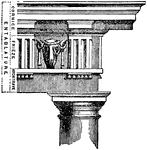Clipart tagged: ‘superstructure’

Entablanture
An entablature refers to the superstructure of moldings and bands which lie horizontally above columns,…

Church Saxon Architecture
Tower of Sompting church, Essex. Saxon Architecture is the earliest stage of native English architecture,…